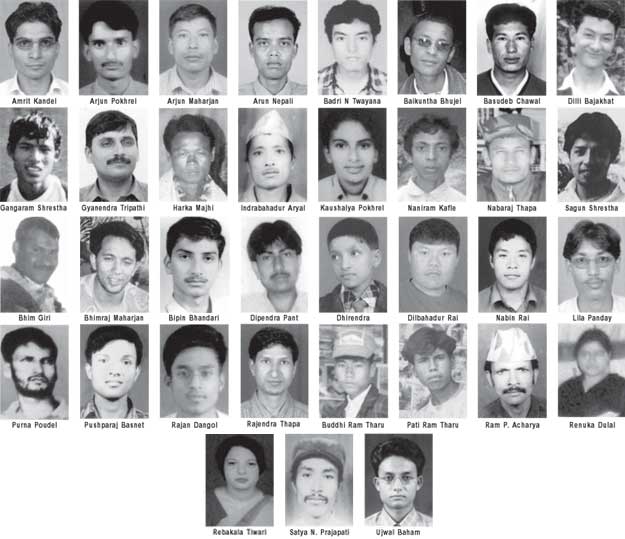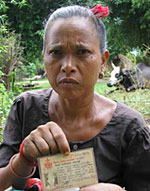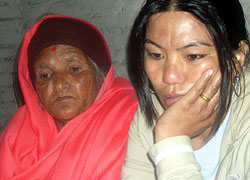|
|
| MISSING: (Left) Motimaya Poudel and Tinam Rai as they relate their struggle to find a son and a brother |
Motimaya Poudel, the frail 70-year-old mother of Purna Poudel who disappeared with two others in 2002 can't stand the uncertainty anymore. She just wants someone to tell her whether Purna is dead or alive.
In Feburary, she went on a hunger strike but that didn't do anything. Increasingly desperate, she joined a group of other families of the disappeared to padlock the office of the National Human Rights Commission (NHRC). Motimaya was arrested in the middle of the night. All this high-profile pressure finally forced the NHRC to agree that it would launch a detailed probe into the fate of those missing.
Nepal has more state sponsored disappearances than any other country going through an armed conflict. In 2001 alone, 1,726 people were reported missing to the NHRC. The whereabouts of 708 of them are still unknown. There are said to be many hundreds more who haven't reported their missing relatives.
Nepali human rights activists are working to raise the issue of state sponsored disappearances in the June meeting of the UN Human Rights Council (the 'reformed' Human Rights Commission, which was closed earlier this month). Meanwhile, members of the NHRC's new working group have started visiting detention centres across the country.
The focus of the investigation is the alleged disappearance two years ago of up to 47 detainees at the Bhairabnath Batallion in Maharajganj who were executed and buried in the Shivapuri National Park (See: 'Prison diary', #290).
Pictures of some of the people believed to have disappeared while under army custody.

DISAPPEARED FAMILIES' SOCIETY
A team has been dispatched to do a DNA analysis of hair and bone samples suspected of being the remains of Sharada Sapkota. Forensic experts involved in the Doramba massacre investigation in 2003 are involved in investigations of disappearances in Kalikot and Dhading. Said one NHRC official privately: "Sooner or later the truth will come out."
 WAITING IN VAIN: Family members and relatives of disappeared people come together to make public the state of their loved ones. |
Even so, there are examples that impunity continues. Among those allegedly involved in the atrocities in Bhairabnath Battallion, one has been posted to the Nepali embassy in Bangladesh and another has been sent on a UN peacekeeping mission. The UN's human rights office in Kathmandu knows about the two.
And many families are still struggling to learn about disappeared relatives. Tinam Rai's brother Dil Bahadur Rai went missing in 2002 about 15 days after his arrest. He has been sighted by other inmates but no one seems to know where he is now. "Other than the fact that he is frail and his hair is long, we haven't been told anything else," says Tinam.
 |
Sharmila Tripathi's husband Gyanendra Tripathi, the leader of the Maoist-affiliated student union, was taken away from Shantinagar in 2003 and hasn't been seen since. "If we knew he was dead, we could deal with the pain," says Sharmila, "but not knowing if he is dead or alive is killing us." The family members of those arrested for their Maoist links says they are not asking that their relatives be released but to be told where they are. They are also critical of the Maoists. "He is my son but he is also their leader, why aren't the Maoists also looking for him?" Motimaya asks. But there is no one who can answer her.
Bhaban's mother
 The mother of 21-year-old Bhaban who was among seven people arrested by the security forces and taken to the Rambhapur barrack shows her son's citizenship certificate to journalists last week.
The mother of 21-year-old Bhaban who was among seven people arrested by the security forces and taken to the Rambhapur barrack shows her son's citizenship certificate to journalists last week.
The seven were on a bus and ravelling to India. Three of the seven the RNA now says were killed in a clash, but doesn't say where it took place and when. Last year, eye witnesses told us they had seen the seven being beaten mercilessly after being arrested. "They must have been killed right there and then," he said. The NHRC's regional office in Nepalganj says 169 people have been disappeared from Banke and Bardiya. But the rights group, Advocacy Forum's count is 247. In reality, the true figure is probably higher than both.



